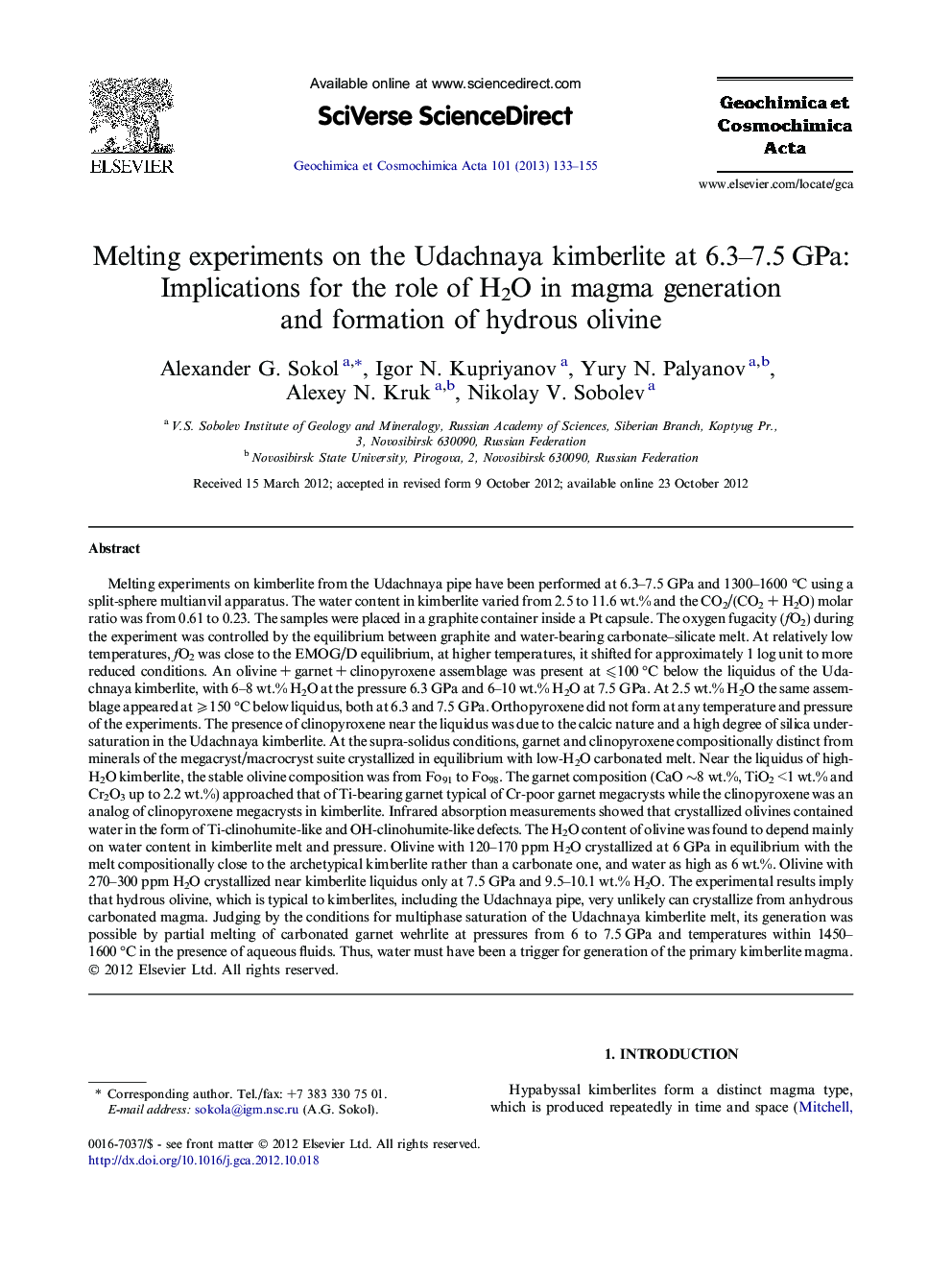| کد مقاله | کد نشریه | سال انتشار | مقاله انگلیسی | نسخه تمام متن |
|---|---|---|---|---|
| 4702528 | 1638056 | 2013 | 23 صفحه PDF | دانلود رایگان |

Melting experiments on kimberlite from the Udachnaya pipe have been performed at 6.3–7.5 GPa and 1300–1600 °C using a split-sphere multianvil apparatus. The water content in kimberlite varied from 2.5 to 11.6 wt.% and the CO2/(CO2 + H2O) molar ratio was from 0.61 to 0.23. The samples were placed in a graphite container inside a Pt capsule. The oxygen fugacity (fO2) during the experiment was controlled by the equilibrium between graphite and water-bearing carbonate–silicate melt. At relatively low temperatures, fO2 was close to the EMOG/D equilibrium, at higher temperatures, it shifted for approximately 1 log unit to more reduced conditions. An olivine + garnet + clinopyroxene assemblage was present at ⩽100 °C below the liquidus of the Udachnaya kimberlite, with 6–8 wt.% H2O at the pressure 6.3 GPa and 6–10 wt.% H2O at 7.5 GPa. At 2.5 wt.% H2O the same assemblage appeared at ⩾150 °C below liquidus, both at 6.3 and 7.5 GPa. Orthopyroxene did not form at any temperature and pressure of the experiments. The presence of clinopyroxene near the liquidus was due to the calcic nature and a high degree of silica undersaturation in the Udachnaya kimberlite. At the supra-solidus conditions, garnet and clinopyroxene compositionally distinct from minerals of the megacryst/macrocryst suite crystallized in equilibrium with low-H2O carbonated melt. Near the liquidus of high-H2O kimberlite, the stable olivine composition was from Fo91 to Fo98. The garnet composition (CaO ∼8 wt.%, TiO2 <1 wt.% and Cr2O3 up to 2.2 wt.%) approached that of Ti-bearing garnet typical of Cr-poor garnet megacrysts while the clinopyroxene was an analog of clinopyroxene megacrysts in kimberlite. Infrared absorption measurements showed that crystallized olivines contained water in the form of Ti-clinohumite-like and OH-clinohumite-like defects. The H2O content of olivine was found to depend mainly on water content in kimberlite melt and pressure. Olivine with 120–170 ppm H2O crystallized at 6 GPa in equilibrium with the melt compositionally close to the archetypical kimberlite rather than a carbonate one, and water as high as 6 wt.%. Olivine with 270–300 ppm H2O crystallized near kimberlite liquidus only at 7.5 GPa and 9.5–10.1 wt.% H2O. The experimental results imply that hydrous olivine, which is typical to kimberlites, including the Udachnaya pipe, very unlikely can crystallize from anhydrous carbonated magma. Judging by the conditions for multiphase saturation of the Udachnaya kimberlite melt, its generation was possible by partial melting of carbonated garnet wehrlite at pressures from 6 to 7.5 GPa and temperatures within 1450–1600 °C in the presence of aqueous fluids. Thus, water must have been a trigger for generation of the primary kimberlite magma.
Journal: Geochimica et Cosmochimica Acta - Volume 101, 15 January 2013, Pages 133–155